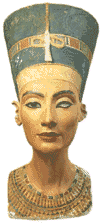
Nefertiti
also spelled Nefertiit , or Nofretete(flourished 14th century BC) queen of Egypt and wife of King Akhenaton (reigned 1353–36 BC) who supported her husband's religious revolution and is thought by some to have adhered to the new cult of the sun god Aton even after the king began to compromise with the upholders of the old order.
Nefertiti is best known for her portrait bust, found at Tell el-Amarna (ancient Akhetaton), the king's new capital. Her parentage is uncertain, but some scholars believe she was an Asian princess from Mitanni. She appears prominently at her husband's side in reliefs found at Tell el-Amarna, and she was a faithful follower of his new cult. Nefertiti had six daughters, two of whom became queens of Egypt. In the 12th year of Akhenaton's reign, or possibly later, Nefertiti either retired after losing favour with the king or, less probably, died. Objects belonging to her have been found at the northern palace in Amarna, suggesting that she may have retired there.
Copyright © 1994-2005 Encyclopædia Britannica, Inc.

